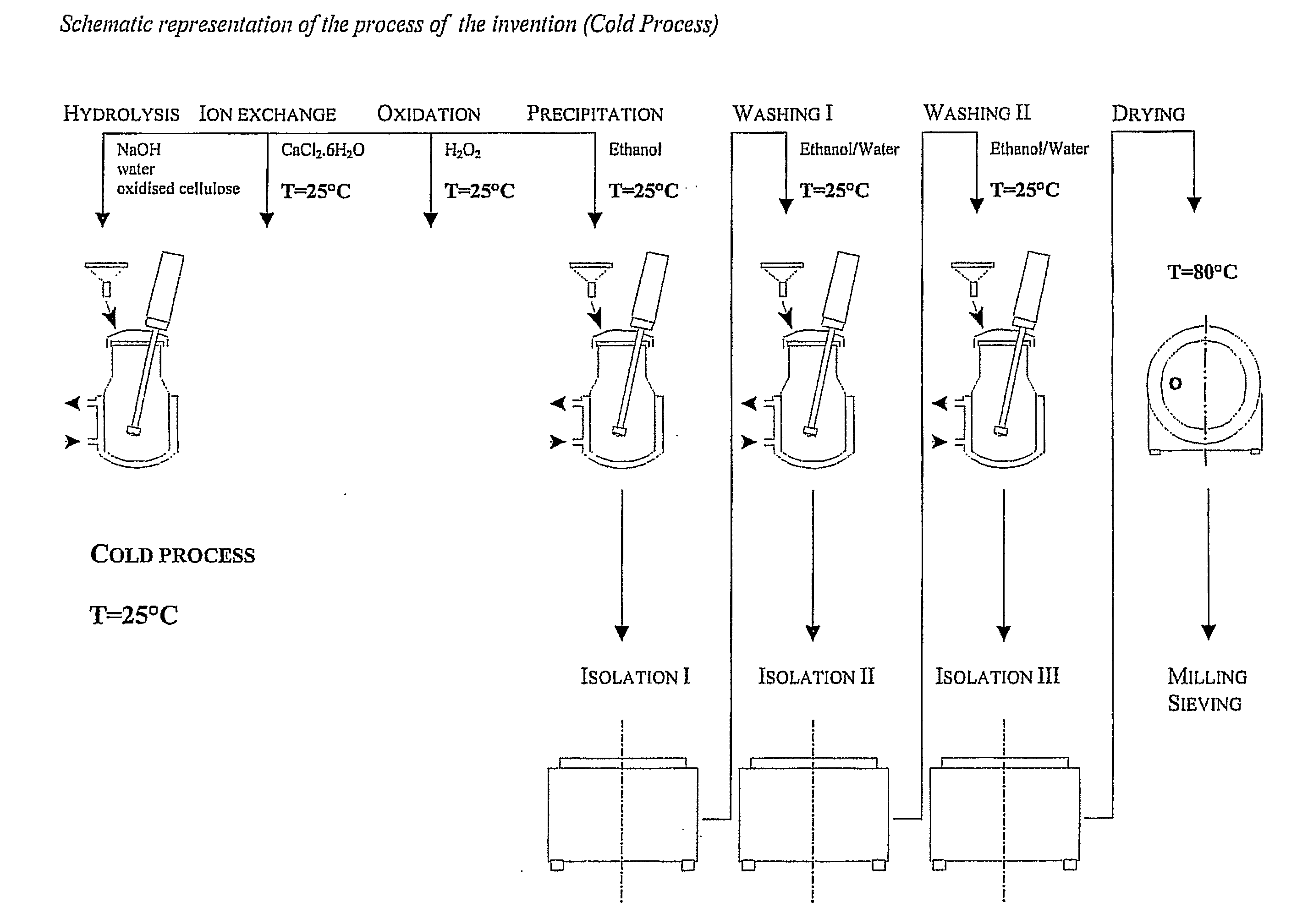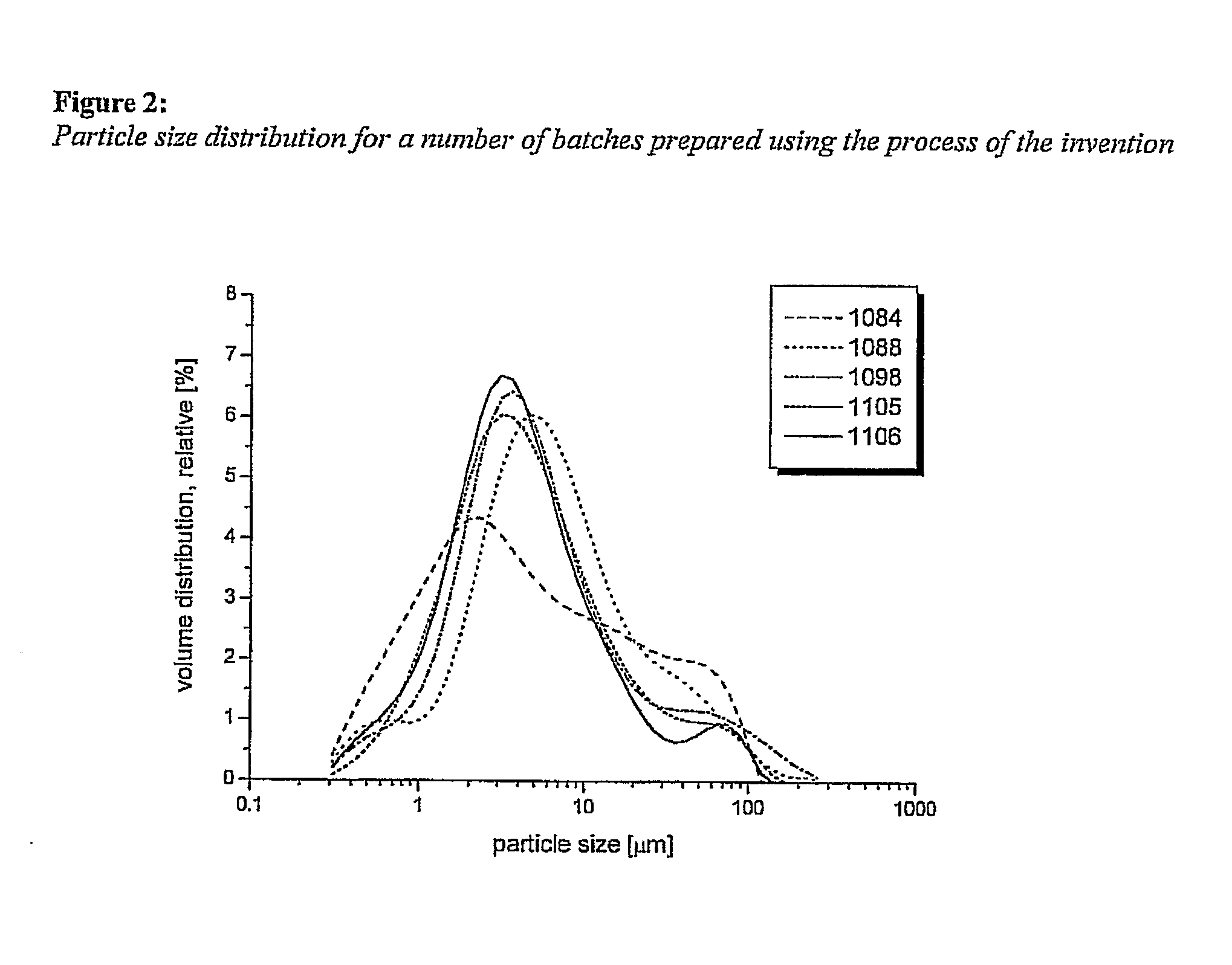Method for preparing polyanhydroglucuronic acid and/or salts thereof
a technology of polyanhydroglucuronic acid and polyanhydroglucuronic acid, which is applied in the preparation of sugar derivatives, pharmaceutical non-active ingredients, sugar derivatives, etc., can solve the problems of high product non-homogeneity, encountering cases of capillary bleeding, and non-uniform oxidative effects of glucane molecules, etc., to achieve the effect of wide application
- Summary
- Abstract
- Description
- Claims
- Application Information
AI Technical Summary
Benefits of technology
Problems solved by technology
Method used
Image
Examples
example 1
Preparation of MDOC Using the Cold Process of the Invention
[0071]In this example, the raw material for preparing a salt of microdispersed polyanhydroglucuronic acid were cotton linters containing 99.1% b / w (by weight) of α-cellulose and oxidised in 60% nitric acid with an admixture of 3.6% nitrous acid at a temperature of 28° C. in analogy with the procedure of GBP 709684.
[0072]Supply 600 l of demineralised water to the reactor, add the 28 kg of Sodium Hydroxide and cool down the formed solution to 20-25° C. while stirring. Prepare solution of Calcium Chloride, hexahydrate, in a polyethylene container, mix 80 l of demineralised water and 54 kg of Calcium Chloride, hexahydrate. Add progressively 140 kg of raw Oxidised Cellulose, prepared from the above defined raw material and dried out at 80° C. for 3 hours to the reactor, which then contains 140 kg dry matter, stirring constantly. During the dosage hold the temperature between 20 and 25° C. The suspension in the reactor discolours ...
example 2
[0073]Five batches of MDOC were produced at room temperature as described in Example 1. Production parameters and result of analyses are summarised in the following Tables 1 to 4.
[0074]Table 1 shows the amounts of components used. Table 2 shows the different production parameters used. Table 3 gives the results of chemical analyses of each of the batches prepared. Table 4 gives the amount of Residuum on a 50 μm sieve of the final dry product. The individual pack numbers within a batch correspond to separately packed and sampled drums.
TABLE 1Lot NoComponent1084108810981105 1106NaOH [kg]2728282828OC dry matter [kg]140140140140140CaCl2•6H2O [kg]5454545454H2O2 [l]3636363636HCl0.76.230.31water in total [l]680680680680680EtOH - recycled [l]16501650165016501650water content in EtOH7.74.35.95.25.2[% vol / vol]EtOH - denatured [l]800800800800800isopropanol [l]8008008008001600
TABLE 2Lot NoParameter1084108810981105 1106dosing of OC [min]105140210180195time of hydrolysis [min]7530304040max tempe...
example 3
[0076]Retrospective comparison was made of the cold process according to the present invention (Examples 1 and 2) and two versions of the original hot process (Comparative Methods I and II).
PUM
| Property | Measurement | Unit |
|---|---|---|
| temperature | aaaaa | aaaaa |
| temperature | aaaaa | aaaaa |
| temperature | aaaaa | aaaaa |
Abstract
Description
Claims
Application Information
 Login to View More
Login to View More - R&D
- Intellectual Property
- Life Sciences
- Materials
- Tech Scout
- Unparalleled Data Quality
- Higher Quality Content
- 60% Fewer Hallucinations
Browse by: Latest US Patents, China's latest patents, Technical Efficacy Thesaurus, Application Domain, Technology Topic, Popular Technical Reports.
© 2025 PatSnap. All rights reserved.Legal|Privacy policy|Modern Slavery Act Transparency Statement|Sitemap|About US| Contact US: help@patsnap.com



